Copper turns green with critical minerals
While not critical, copper is vital to world's electric future
Last updated 6/22/2020 at 11:08am
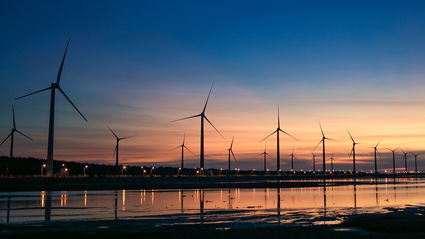
Pexels
Wind turbines and other forms of renewable energy require roughly five metric tons of copper for every megawatt-hour of electrical generation capacity.
While copper is not on the United States Geological Survey's list of 35 minerals and metals critical to America, there is no doubt of this metal's importance to both the everyday and avant-garde technologies vital to America's economy and security.
"None of the other critical minerals work without copper," Trilogy Metals President and CEO Rick Van Nieuwenhuyse told Mining News.
Automobiles are a prime example of how emerging technologies and green energy will drive the demand for copper into the future.
It is estimated that fully electric cars, such as Tesla's S, 3, X and Y models, contain around 180 pounds of copper, which is roughly 4 to 10 times more than the 18-49 lb in a conventional internal combustion vehicle.
The are currently nearly 4 million electric cars on global highways, a figure that is expected to swell to 125 million by 2030, according to the International Energy Agency (IEA). This equates to roughly 22.9 billion lb (10.4 million metric tons) of copper needed just to build EVs over the next 11 years. This does not account for the increased electrical infrastructure or demand these vehicles will drive, all of which will also need copper.
And IEA thinks its electric car projections could be conservative.
"Should policy ambitions rise even further to meet climate goals and other sustainability targets, ... the number of electric cars on the road could be as high as 220 million in 2030," the international energy policy organization wrote.
While Alaska does not currently have a copper producing mine in operation, it is a past supplier of this critical electric conductor and has billions of pounds in deposits ready to deliver this green metal to world markets in the coming years.
And many of these copper deposits have the potential to produce significant quantities of other minerals and metals that are on the USGS critical list. Barite, cobalt, germanium, gallium and rhenium are among the critical commodities found in some of Alaska's advanced copper exploration projects.
People, green energy & EVs
While more than 2 billion lb of copper per year going into electric cars is going to play a role in driving up demand for this metal, the EV sector is only a part of the story. The growing amount of electricity needed to power these vehicles, the push for greener sources of that electricity and a growing populace that requires more electricity per capita contributes much of the rest of this tale.
More than 25,000 terawatt hours, or 25 billion megawatt hours, of electricity was generated worldwide during 2017, roughly double the electrical generation in 1990. This trend is not expected to abate anytime soon and the transition to greener sources of this electricity will call for much more copper.
It is estimated that renewable energy power generation, such as solar and wind, require approximately five metric tons of copper for every megawatt-hour of electric generation, which is around five times more copper than traditional power sources, such as coal and natural gas.
This does not take into account the additional copper wire to connect the power generation source to the grid.
"So, if we want less CO2 going into the atmosphere, we need to produce more copper under it!" Van Nieuwenhuyse wrote in a 2018 column on copper and its role in green energy.
While green energy and other modern applications are exciting drivers of copper demand in the coming years, more basic economic and social developments add to and underly the growing global need for this metal.
By 2030, roughly 59.7 percent of the global populace will live in urban regions, a roughly 4.8 percent increase from current levels.
The promise of economic prosperity is the major factor in this migration to metropolitan areas. Better income and the conveniences inherent to urban living equates to new homes, more consumer goods, expanded electrical grids and a lot more copper.
This urbanization is especially pronounced in China, already the largest copper consumer, and India, where copper demand is growing by around 8 percent per year.
Carbonate-hosted Bornite
Van Nieuwenhuyse's interest in the future demand of copper is rooted in the roughly 9 billion pounds of copper Trilogy Metals has identified so far at Arctic and Bornite – two deposits at the Upper Kobuk Mineral Projects (UKMP) in the Ambler Mining District of Northwest Alaska.
Arctic, the most advanced UKMP project, hosts roughly 2.5 billion lb of this copper, along with zinc, lead, gold and silver.
A prefeasibility study completed in 2019 details plans for an open-pit mine to extract the volcanogenic massive sulfide mineralization at Arctic and a 10,000-metric-ton-per-day mill to produce metals-rich concentrates to deliver to markets.
The largest copper prize identified so far at UKMP, however, is Bornite.
According to the most recent resource calculation, the Bornite project hosts roughly 6.4 billion lb of copper and 77 million lb of cobalt.
Bornite also carries at least two other critical minerals – germanium and gallium – though the concentrations and recoverability of these metals has yet to be determined.
To gain a better understanding of the distribution of these potential byproduct metals at Bornite, as well as to investigate the deposit's rhenium potential, Trilogy Metals entered into a technical assistance agreement with the USGS. In addition to providing Trilogy with data on these potential byproduct metals, this work will enable the USGS to assess the potential for critical mineral resources in carbonate-hosted deposits in Alaska and elsewhere.
More information on cobalt and the Bornite deposit can be found in Batteries create critical cobalt situation in this magazine.
The Pebble giant
Bornite is not the only advanced stage copper project in Alaska known to carry critical minerals – the giant Pebble deposit hosts a globally significant amount of rhenium.
Most of the world's rhenium is produced as a byproduct from porphyry copper-molybdenum deposits like Pebble.
Considered the largest undeveloped copper deposit on Earth, Pebble hosts 6.46 billion metric tons of measured and indicated resource averaging 0.4 percent (56.9 billion lb) copper, 0.34 g/t (70.6 million oz) gold, 240 parts per million (3.4 billion lb) molybdenum and 1.7 g/t (344.6 million oz) silver.
Pebble Partnership, the company hoping to build a mine at this world-class porphyry deposit, submitted permit applications for an operation that would mine roughly 10 percent of this resource over two decades.
The reason for this modest mine in relation to the deposit size is to address concerns over potential impacts to the salmon fisheries in the region of Southwest Alaska where Pebble is located.
Federal permitting is being spearheaded by the United States Army Corps of Engineers, which released a draft environmental impact statement for Pebble in February.
The Pebble Mine under consideration in this draft EIS is expected to produce 5.74 billion lb of copper, 6.4 million oz of gold, 260 million lb of molybdenum and 32 million oz of silver over this 20-year mine life.
Pebble Partnership said this plan demonstrates the thoroughness and thoughtfulness that its engineers put into designing an environmentally optimized mine for Pebble.
"We have stated that the project must co-exist with the important salmon fishery in the region and we believe we will not harm the fish and water resources in Bristol Bay," said Pebble Partnership CEO Tom Collier. "Now we have a science-based, objective assessment of the project that affirms our work."
In addition to providing global markets with roughly 287 million lb of copper, 320,000 oz of gold, 13 million lb of molybdenum and 1.6 million oz of silver per year, Pebble has the potential to be a significant supplier of rhenium.
Calculations completed in 2011 estimates that these resources contain roughly 0.45 g/t rhenium, which equates to around 2.9 million kilograms, or roughly US$6.4 billion of the critical superalloy metal.
This is enough rhenium to supply America's total needs for nearly six decades at 2018 consumption levels and does not account for the rhenium contained in the 4.45 billion metric tons of inferred resource outlined at Pebble.
More information on rhenium and the Pebble deposit can be found in Rhenium – the hot superalloy element in this publication.
Barite at Palmer
Palmer, a copper-rich volcanogenic massive sulfide deposit in Southeast Alaska, hosts a massive quantity of another mineral critical to the U.S. – barite.
While best known for its copper, zinc, silver and gold, the deposits outlined so far at Palmer contain around 3.8 million metric tons of barite. This is more than 25 percent of the weight of the entire deposits, which also happens to carry 1.6 billion lb zinc, 278 million lb of copper and 25 million oz of silver.
Palmer project partners Constantine Metal Resources Ltd. (51 percent) and Dowa Metals & Mining Co. Ltd. (49 percent) are investigating the potential of selling the barite as a co-product to the base and precious metals that would be extracted if a mine is developed there.
Considering that Palmer is only about 45 miles from a Pacific Rim port and the barite would be handled as part of the mining process, this critical industrial mineral has the potential to add an important revenue stream to any future operation developed at the VMS project.
"This may have very positive implications with the potential to both enrich gross metal value per tonne (metric ton) and provide significant environmental and operational benefits by reducing waste," said Constantine Metal President Garfield MacVeigh.
More information on barite, its uses and market can be found in Barite weighs in on critical minerals list in this magazine.
Alaska's abundant copper
Whether it be carbonate-hosted, porphyry or VMS, deposits that could provide future supplies of copper are abundant in Alaska.
USGS and Alaska Division of Geological & Geophysical Surveys have identified several areas of the state prospective for carbonate-hosted copper deposits.
A geospatial tool developed by the federal and state agencies found that almost the entire length of the Brooks Range, mountains that separate the oil-rich North Slope from the rest of the state, to be a good place to look for this style of copper deposit that sometimes carry cobalt, germanium and gallium.
In addition, the USGS study identified two areas of the Seward Peninsula in western Alaska and the Wrangellia terrane, a distinct belt of rocks along much of the southern slopes of the Alaska Range, as prospective for carbonate-hosted copper deposits similar to Trilogy Metals’ Bornite project.
In recent years, several porphyry deposits in Alaska have drawn the interests of mining companies looking for stores of copper similar to Pebble.
Two of the world's largest mining companies – Freeport-McMoRan and Rio Tinto – have quietly nabbed interests in porphyry copper-gold projects in eastern Alaska.
Freeport-McMoRan has entered an agreement to option Tanacross – a porphyry copper-gold project that lies right against the Yukon border about 50 miles northeast of Tok, Alaska – from Kenorland Minerals, a privately held project generating explorer.
Kennecott Exploration, the exploration arm of Rio Tinto, has optioned the Oreo Mountain project about 10 miles southwest of the Tanacross property from another privately held explorer, Tubutulik Mining Company.
Given the early stage of exploration at Tanacross and Oreo, Freeport and Rio Tinto have not released details from their exploration or future plans from the eastern Alaska projects.
South32 Ltd. is the most recent major to invest in Alaska’s porphyry copper potential.
Early in 2018, South32 entered into an option agreement to acquire up to 70 percent in Freegold Ventures Ltd.’s Shorty Creek porphyry deposit about 75 miles northwest of Fairbanks.
While also early stage, Shorty Creek shows the potential to host the size majors are interested in.
For example, one hole drilled in 2017 cut 408 meters averaging 0.27 percent copper, 0.05 g/t gold, 4.97 g/t silver and 0.05 percent tungsten trioxide.
Another hole drilled in 2018 cut 442.2 meters of 0.24 percent copper, 0.09 g/t gold, 4.74 g/t silver and 0.02 percent tungsten trioxide.
While not as valuable as the copper and the gold in the emerging deposit, the tungsten grades at Hill 1835 could provide a source of this critical metal as a by-product.
South32 has agreed to invest up to US$10 million to explore the porphyry potential at Shorty Creek over a four-year span, including US$2 million during 2019.
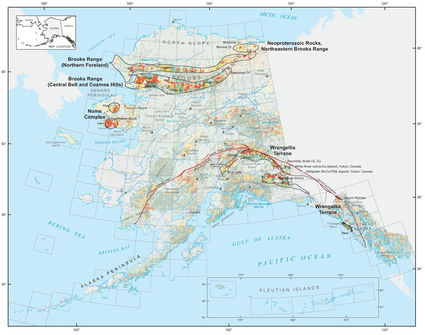
United States Geological Survey
A geopatial tool developed by USGS and Alaska DGGS found that almost the entire length of the Brooks Range to be a good place to look for the carbonate-hosted copper deposits that sometimes carry cobalt, germanium and gallium.
The Australia-based major is also funding exploration at Trilogy Metals’ Upper Kobuk Mineral Projects as part of an option to earn a 50 percent interest in this world-class copper district.
PolarX Ltd., an Australia-based junior, is also on the hunt for large porphyry deposits in Alaska.
This company has already outlined a high-grade skarn deposit, often found on the periphery of porphyries, with 90.4 million lb of copper, 213,000 oz gold and 1.5 million oz of silver.
This skarn, known as Zackly, lies in the middle of a 7.5-mile- (12 kilometers) long structural corridor bookended by the Mars and Saturn porphyry gold-copper prospects.
Mars and Saturn have the classic geochemical and geophysical signatures associated with porphyry deposits. Neither, however, have ever been drilled – a dearth that PolarX plans to remedy in 2019.
And, who knows, this drilling could turn up critical metals such as rhenium or tungsten that often come along with the copper needed to power the world’s electrical future.



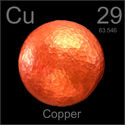
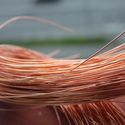
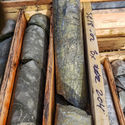
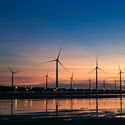
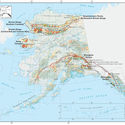
















Reader Comments(0)